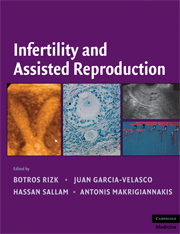Book contents
- Frontmatter
- Contents
- Contributors
- Foreword
- Preface
- Introduction
- PART I PHYSIOLOGY OF REPRODUCTION
- PART II INFERTILITY EVALUATION AND TREATMENT
- PART III ASSISTED REPRODUCTION
- PART IV ETHICAL DILEMMAS IN FERTILITY AND ASSISTED REPRODUCTION
- 69 Stem Cell Research
- 70 Fertility Preservation in Female and Male Cancer Patients
- 71 Ethical Dilemmas in ART: Current Issues
- 72 Infertility Treatment in Perimenopausal Women: Ethical Considerations
- 73 Religious Perspectives of Ethical Issues in Inferility and ART
- 74 The Future of Assisted Reproduction
- Index
- Plate section
- References
69 - Stem Cell Research
from PART IV - ETHICAL DILEMMAS IN FERTILITY AND ASSISTED REPRODUCTION
Published online by Cambridge University Press: 04 August 2010
- Frontmatter
- Contents
- Contributors
- Foreword
- Preface
- Introduction
- PART I PHYSIOLOGY OF REPRODUCTION
- PART II INFERTILITY EVALUATION AND TREATMENT
- PART III ASSISTED REPRODUCTION
- PART IV ETHICAL DILEMMAS IN FERTILITY AND ASSISTED REPRODUCTION
- 69 Stem Cell Research
- 70 Fertility Preservation in Female and Male Cancer Patients
- 71 Ethical Dilemmas in ART: Current Issues
- 72 Infertility Treatment in Perimenopausal Women: Ethical Considerations
- 73 Religious Perspectives of Ethical Issues in Inferility and ART
- 74 The Future of Assisted Reproduction
- Index
- Plate section
- References
Summary
ABSTRACT
Nowadays, stem cell represents one of the most promising research areas in regenerative medicine. They are defined by two basic properties: the ability to proliferate by a process of self-renewal and the potential to differentiate into specialized cell types. According to their origin, they can be classified as embryonic or adult stem cells.
Human embryonic stem cells (hESCs) are pluripotent cell lines derived from the inner cell mass (ICM) of human blastocyst. The differentiation potential of these cells to the three embryonic germ layers make them an attractive research tool for the study of early human developmental process as well as a potential therapeutic tool for various human diseases. hESCs are also invaluable research tools to study embryonic development and can serve as a platform to develop and test new therapies.
INTRODUCTION
The discovery and characterization of hESCs have revolutionized the scientific community due to the potential therapeutic use of these pluripotent cells. At the same time, research with hESCs is an extremely controversial and politicized issue in our society.
Reports on embryonic stem cells were first introduced by Cole et al. in the early sixties using rabbit blastocysts (1,2). Mouse embryonic stem cells (mESC) were isolated from ICM of murine preimplantation embryos (3,4). mESC are capable of proliferating indefinitely in an undifferentiated state and are pluripotent, making them a perfect vehicle for genetic manipulations in mice.
Keywords
- Type
- Chapter
- Information
- Infertility and Assisted Reproduction , pp. 695 - 705Publisher: Cambridge University PressPrint publication year: 2008



